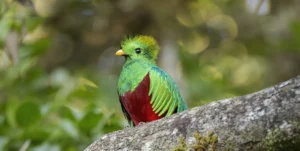
Have you ever seen a living gem? We invite you to be mesmerized by the splendor of the majestic Quetzal, revered by the Aztecs as the embodiment of Quetzalcóatl, their supreme god.
At Savegre, we have a tour specially designed for you to enjoy one of the most beautiful and iconic birds in the Americas. It begins early in the morning and is guided by one of our experts who will take you to the places where the Quetzal feeds on aguacatillos, its favorite fruit.
Just a few seconds of observation will be enough to understand why it is considered the most beautiful species on the American continent—a true natural treasure with resplendent green plumage and a long, vibrant tail.
Make your reservation with our team or at the reception. We offer options for both small and large groups, making it perfect for families, couples, and solo adventurers.
The approximate duration of this tour is 2 hours and 15 minutes, starting at 5:15 am and ending at 7:30 am, and it is available to all our visitors.